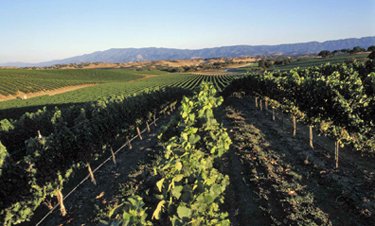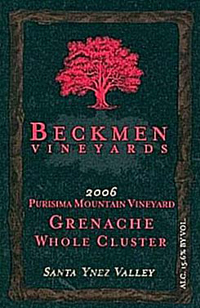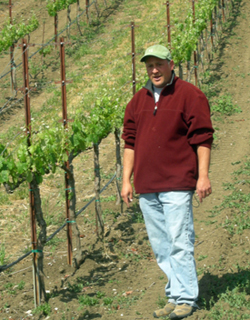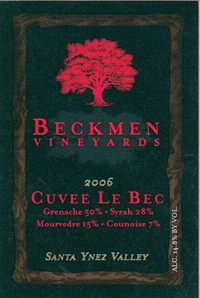
and-Steve320.jpg)
A Family Affair: Steve Beckmen and his father Tom (right) have seen the sensory and financial advantages to using biodynamic growth methods for their Rhone varietals.
The Biodynamic Story
of Beckmen Vineyards
One of the hardest things to do in biodynamics is to actually make the decision to try it. Once you make the decision, everything seems to fall into place. We saw good results almost immediately.
~ Steve Beckmen
by
Dennis Schaefer
April 14, 2008
Dennis Schaefer (DS): What attracted your family to the wine business?
Steve Beckmen (SB): I think what attracted us the most was the Santa Ynez Valley and the great potential we saw there for growing world-class wines. At the time, Santa Barbara County was not
Rhone varietals thrive in the Beckmen’s Purisma Mountain Vineyard in Santa Ynez Valley.seen as a highly regarded appellation, but after tasting some of the wines, and seeing and embracing the passion others had for the area, we became believers. We were also excited by the fact that we were not only creating a winery, we were helping the area to achieve its potential.
DS: How did you come to the conclusion that Rhone varietals were the way to go?
SB: The wines determined the direction. The most exciting wines we made, the ones with the most potential, were the Rhône varietals. The Syrah, which was purchased from the original Stolpman and Thompson Vineyard plantings, stood out the most. In addition, we were excited about the Grenache, which was also from the original Stolpman plantings. These were clearly the best wines we had ever made in the short time we had been making wines.
It seemed obvious, yet a bit risky, to go in this direction because, at the time, these were relatively unknown or misunderstood varietals in the marketplace. One other factor that I constantly thought about was trying to establish an identity for the middle part of the Santa Ynez Valley. This area was not Pinot or Chardonnay country, and the history of Cabernet and other Bordeaux varieties was mixed at best. Great growing regions usually have one wine or group of grapes that identifies that region, but there was not yet such an identifying grape for this area. Rhône grapes were the identity that I, along with a few others, was seeking for the area. I think that we have been successful in finding our identity, and that identity is building.
was mixed at best. Great growing regions usually have one wine or group of grapes that identifies that region, but there was not yet such an identifying grape for this area. Rhône grapes were the identity that I, along with a few others, was seeking for the area. I think that we have been successful in finding our identity, and that identity is building.
DS: What was the impetus for taking a 365-acre property in Santa Ynez Valley and planting Purisima Mountain Vineyard?
SB: There are a couple of reasons that we decided to plant Purisima, both of which relate to our desire to get the highest quality fruit. After a few years of buying fruit from "growers," it became clear that there was a big difference between how we wanted the vineyards managed and how the growers wanted to manage them. By planting our own vineyard, we were able to take full control over every aspect of the farming, from development to day-to-day management. Now we are doing things the way we want them done, all with the aim of achieving the highest quality fruit possible. We also love the uniqueness of having an estate-grown winery in California; there are so few.
DS: Did you consider planting that vineyard a gamble?
SB: I would say it was a bit of a gamble, because we planted in a relatively new area, and were looking to plant "new" varieties like Grenache and Syrah. How much of a gamble is debatable. The biggest concern is always quality. We didn’t just want to plant a vineyard; we wanted to establish a vineyard capable of producing world-class wine grapes.
DS: How did you learn about and come to embrace biodynamics at Purisima Mountain Vineyard?
SB: I first heard about biodynamics from a college friend who had embraced the philosophy for his backyard garden in 1995. After hearing some of the ideas, I was skeptical about how the philosophy could be applied on a much larger scale. After a couple of years of tasting the
Steve Beckmen can often be found walking through the Purisma Mountain Vineyard.fruits of his labor, I was convinced there was something there. He was growing some of the finest fruits and vegetables I had ever seen or tasted.
In 1999, a very tall Frenchman named Philippe Armenier approached my table at Hospice du Rhône and started talking about biodynamics. Philippe spoke from first hand experience - he and his family were the first to embrace biodynamics in Châteauneuf-du-Pape at his family estate, Domaine de Marcoux.
During the 2001 growing season, Philippe stopped by the winery and we had some intense discussions. By this time, I had tasted many biodynamically grown wines, and was seeing consistently exciting things, both in terms of quality and flavor. Many of these wines possessed a complexity, terroir and elegance that were quite impressive. I decided to start doing a trial of 17 acres of Syrah on Purisima Mountain Vineyard, using only biodynamic practices.
One of the hardest things to do in biodynamics is to actually make the decision to try it. Once you make the decision, everything seems to fall into place. We saw good results almost immediately, and I soon decided to expand the trial to 42 acres. Over the next couple of seasons we stayed at 42 acres, until the 2006 season when we were in the right position to make the move to 100 percent biodynamic farming on our Purisima Mountain Vineyard.
DS: What does biodynamics involve? At Purisima, do you pick and choose from the biodynamics menu (as some vintners do) or do you do the whole nine yards?
SB: In order to try biodynamics fully, we embraced the whole of the practice, spraying all the preparations, following the calendar, composting, etc. I believed that if we were going to try biodynamics and get a true sense of its merits, we needed to do it right, not in pieces. Today, we continue to embrace the philosophy fully; however we have learned how to tailor the practices in different parts of the vineyard. Some blocks need more of some things and less of others, which is something any good farmer understands. We are not where I would ultimately like us to be with biodynamics, but we are getting there. It is an evolving process.
 At some point I would love to make the Purisima Mountain property a fully functional single-farm organism, where we have our own livestock feeding our soils, where we grow diverse gardens, vegetables, fruits, hay, and make our own biodynamic preparations, etc. We are slowly building to this point, and it is definitely my long-term goal.
At some point I would love to make the Purisima Mountain property a fully functional single-farm organism, where we have our own livestock feeding our soils, where we grow diverse gardens, vegetables, fruits, hay, and make our own biodynamic preparations, etc. We are slowly building to this point, and it is definitely my long-term goal.
DS: You did controlled trials, both in the vineyard and tasting the finished wines: that is, conventionally farmed grapes vs. biodynamically farmed grapes. What were the results of your trials and what conclusions did you reach?
SB: We started out with a trial of 17 ac
Steve Beckmen (SB): I think what attracted us the most was the Santa Ynez Valley and the great potential we saw there for growing world-class wines. At the time, Santa Barbara County was not

Rhone varietals thrive in the Beckmen’s Purisma Mountain Vineyard in Santa Ynez Valley.
DS: How did you come to the conclusion that Rhone varietals were the way to go?
SB: The wines determined the direction. The most exciting wines we made, the ones with the most potential, were the Rhône varietals. The Syrah, which was purchased from the original Stolpman and Thompson Vineyard plantings, stood out the most. In addition, we were excited about the Grenache, which was also from the original Stolpman plantings. These were clearly the best wines we had ever made in the short time we had been making wines.
It seemed obvious, yet a bit risky, to go in this direction because, at the time, these were relatively unknown or misunderstood varietals in the marketplace. One other factor that I constantly thought about was trying to establish an identity for the middle part of the Santa Ynez Valley. This area was not Pinot or Chardonnay country, and the history of Cabernet and other Bordeaux varieties
 was mixed at best. Great growing regions usually have one wine or group of grapes that identifies that region, but there was not yet such an identifying grape for this area. Rhône grapes were the identity that I, along with a few others, was seeking for the area. I think that we have been successful in finding our identity, and that identity is building.
was mixed at best. Great growing regions usually have one wine or group of grapes that identifies that region, but there was not yet such an identifying grape for this area. Rhône grapes were the identity that I, along with a few others, was seeking for the area. I think that we have been successful in finding our identity, and that identity is building.
DS: What was the impetus for taking a 365-acre property in Santa Ynez Valley and planting Purisima Mountain Vineyard?
SB: There are a couple of reasons that we decided to plant Purisima, both of which relate to our desire to get the highest quality fruit. After a few years of buying fruit from "growers," it became clear that there was a big difference between how we wanted the vineyards managed and how the growers wanted to manage them. By planting our own vineyard, we were able to take full control over every aspect of the farming, from development to day-to-day management. Now we are doing things the way we want them done, all with the aim of achieving the highest quality fruit possible. We also love the uniqueness of having an estate-grown winery in California; there are so few.
DS: Did you consider planting that vineyard a gamble?
SB: I would say it was a bit of a gamble, because we planted in a relatively new area, and were looking to plant "new" varieties like Grenache and Syrah. How much of a gamble is debatable. The biggest concern is always quality. We didn’t just want to plant a vineyard; we wanted to establish a vineyard capable of producing world-class wine grapes.
DS: How did you learn about and come to embrace biodynamics at Purisima Mountain Vineyard?
SB: I first heard about biodynamics from a college friend who had embraced the philosophy for his backyard garden in 1995. After hearing some of the ideas, I was skeptical about how the philosophy could be applied on a much larger scale. After a couple of years of tasting the

Steve Beckmen can often be found walking through the Purisma Mountain Vineyard.
In 1999, a very tall Frenchman named Philippe Armenier approached my table at Hospice du Rhône and started talking about biodynamics. Philippe spoke from first hand experience - he and his family were the first to embrace biodynamics in Châteauneuf-du-Pape at his family estate, Domaine de Marcoux.
During the 2001 growing season, Philippe stopped by the winery and we had some intense discussions. By this time, I had tasted many biodynamically grown wines, and was seeing consistently exciting things, both in terms of quality and flavor. Many of these wines possessed a complexity, terroir and elegance that were quite impressive. I decided to start doing a trial of 17 acres of Syrah on Purisima Mountain Vineyard, using only biodynamic practices.
One of the hardest things to do in biodynamics is to actually make the decision to try it. Once you make the decision, everything seems to fall into place. We saw good results almost immediately, and I soon decided to expand the trial to 42 acres. Over the next couple of seasons we stayed at 42 acres, until the 2006 season when we were in the right position to make the move to 100 percent biodynamic farming on our Purisima Mountain Vineyard.
DS: What does biodynamics involve? At Purisima, do you pick and choose from the biodynamics menu (as some vintners do) or do you do the whole nine yards?
SB: In order to try biodynamics fully, we embraced the whole of the practice, spraying all the preparations, following the calendar, composting, etc. I believed that if we were going to try biodynamics and get a true sense of its merits, we needed to do it right, not in pieces. Today, we continue to embrace the philosophy fully; however we have learned how to tailor the practices in different parts of the vineyard. Some blocks need more of some things and less of others, which is something any good farmer understands. We are not where I would ultimately like us to be with biodynamics, but we are getting there. It is an evolving process.
 At some point I would love to make the Purisima Mountain property a fully functional single-farm organism, where we have our own livestock feeding our soils, where we grow diverse gardens, vegetables, fruits, hay, and make our own biodynamic preparations, etc. We are slowly building to this point, and it is definitely my long-term goal.
At some point I would love to make the Purisima Mountain property a fully functional single-farm organism, where we have our own livestock feeding our soils, where we grow diverse gardens, vegetables, fruits, hay, and make our own biodynamic preparations, etc. We are slowly building to this point, and it is definitely my long-term goal.
DS: You did controlled trials, both in the vineyard and tasting the finished wines: that is, conventionally farmed grapes vs. biodynamically farmed grapes. What were the results of your trials and what conclusions did you reach?
SB: We started out with a trial of 17 ac










 READER FEEDBACK: To post your comments on this story,
READER FEEDBACK: To post your comments on this story,



